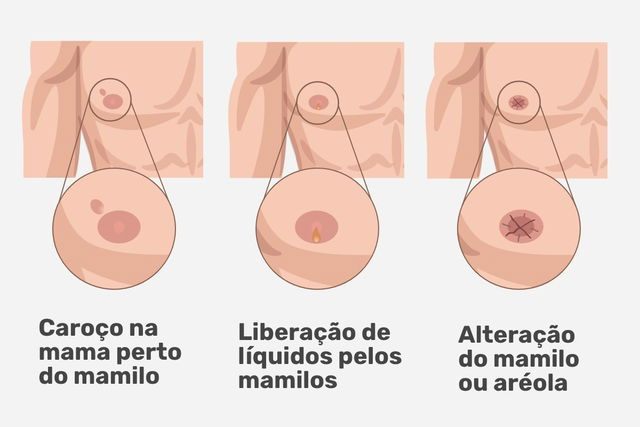The main signs of breast cancer include a palpable nodule or lump in the breast that does not hurt, changes in nipple color, nipple discharge, lumps in the armpit, an itchy breast or nipple, and visible ripples or texture changes in the breast.
These symptoms may appear one at a time or in clusters, and can indicate early to advanced breast cancer. The presence of any of these symptoms does not necessarily mean cancer cells are present. However you should see a doctor for further assessment, as these symptoms could be a sign of a benign nodule or breast tissue inflammation.
Signs and symptoms of breast cancer
The main signs of breast cancer are:
- A palpable nodule or lump that does not hurt
- Changes in nipple color;
- Nipple discharge
- Unilateral breast swelling or changes in breast size
- Palpable lumps in the armpit
- Crusting or lesions on the skin near the nipple
- Change in areola color or shape
- Visible veins in the breast that increase in size
- Breast or nipple itching
- Grooves in the breast
- Change in the characteristics of the breast skin, such as a redder color or rougher skin.
These changes can be identified with regular self-breast exams or with periodic breast assessments by a health care professional. Performing self-exams can help you to understand your normal anatomy and keep you aware of changes over time.
Also recommended: Lump in Breast: 7 Common Causes & Treatment tuasaude.com/en/breast-lumpOnline symptom checker
To determine your risk for breast cancer, enter your symptoms below:
{TEST_SYMPTOMS_BREAST_CANCER}
This quiz is only a guidance tool. It does not provide a diagnosis or replace a consult with your doctor.
Breast cancer in men

Breast cancer in men presents with similar symptoms of breast cancer in women. Any changes to breast tissue should be assessed by a doctor for diagnosis and treatment as necessary.
Who is most at-risk?
Anyone, men or women, can be diagnosed with breast cancer. Populations with a higher risk for breast cancer include:
- Age greater than 50 years
- Family history of breast cancer
- Obesity and sedentary lifestyle
There are also genetic findings that can increase your risk for developing breast cancer such as the presence of BRCA1 and BRCA2 genes. There are genetic tests that can be done to determine whether a patient carries these genes, which allows the chance to intervene before the cancer even develops.
Main types of breast cancer
There are several different types of breast cancer, which depend on how they develop. Some are more aggressive than others. The main types of breast cancer include:
- Ductal carcinoma in situ (DCIS): This is a type of early-stage breast cancer that develops in the ducts and is associated with a high cure rate.
- Lobular carcinoma in situ (LCIS): This is the second most common type in women and is also typically caught in its early stages. This cancer is located in the milk-producing glands. This type of cancer is not very aggressive and easy to treat.
- Invasive ductal carcinoma (IDC): This is the most common type of breast cancer and refers to a more advanced stage in which the cancer started in the milk-producing gland, but has spread outside, potentially creating metastases.
- Invasive lobular carcinoma (ILC): This type is rarer and often more difficult to identify. It may also be related to the emergence of ovarian cancer;
- Inflammatory breast carcinoma: This is an aggressive cancer, but is more rare.
In addition to these types of breast cancer, there are also others that are even rarer, such as medullary carcinoma, mucinous carcinoma, tubular carcinoma or malignant phyllodes tumor.
Symptoms of advanced breast cancer
Symptoms of advanced malignant breast cancer are characterized by worsening of the symptoms above as well as lesions in the breast. Other signs that are unrelated to the breast tissue may also emerge, such as nausea, bone pain, loss of appetite, severe headaches and muscle weakness.
Also recommended: Breast Pain: 11 Common Causes (& When to See a Doctor) tuasaude.com/en/breast-painGenerally, these symptoms are related to advanced metastatic cancer that has spread to other tissues or organs in the body, such as the lungs and brain. You should report these symptoms to your doctor as soon as you notice them.
How to prevent
Breast cancer can be prevented by opting for healthy lifestyle. You should maintain a balanced and healthy diet, with fruits and vegetables, and exercise regularly. Avoid heavy alcohol intake and quit smoking.
You should also undergo regular mammograms, which can pick-up early changes to the breast. The America Cancer Society advises that women between the ages of 45 and 54 should get early mammograms, while women over 55 should get one every two years. Women with risk factors for breast cancer, such as first-degree relatives with breast or ovarian cancer should start screening at age 30.
It is also important to perform a monthly breast self-examinations to become familiar with your normal breast anatomy and to pick-up on early changes.
